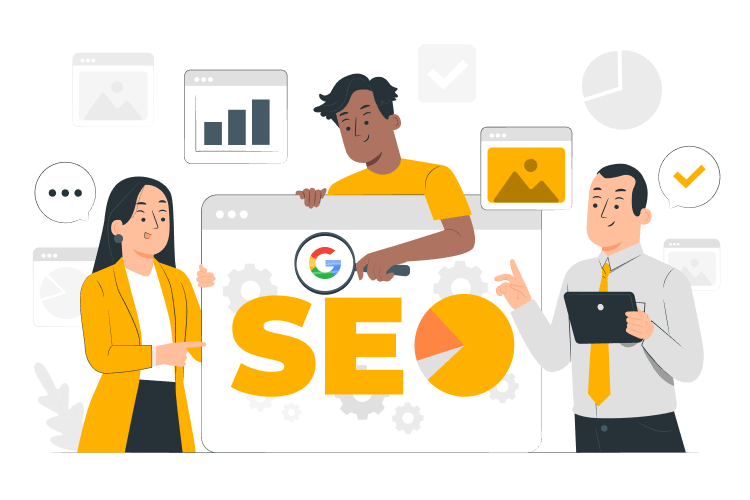
Introduction
Performing Search engine optimization on a website feels like solving a large puzzle by placing small pieces bit by bit, all of which work independently as well as interrelatedly at the same time. This is why to explain SEO and its components to you in a detailed manner, here are the most vital pieces of the SEO puzzle, which when placed right will help in achieving success for a brand in terms of both search rankings and lead generation.
Vital Parts of SEO You Need to Understand for Achieving Success
In the current digital era, anyone vying to become a digital marketing expert needs to understand the following vital parts that are prerequisites for their success.
Your Audience and Industry
Knowing which industry your business falls under and the audience you want to target is highly significant for occurring in search results and increasing online visibility as it helps to better target your customers through your content.
Along with industry insights, knowing about your competitors in the industry is also a popular tactic as it not only tells you what your competitors are doing but also what they are missing so that you can leave the crowd behind and take your website ranking above the competitors.
User Intent
Understanding the intent with which a user is searching something online is very important for marketers as it can help in describing how keywords can be placed in the content for better targeting.
There are various intents while searching for something on the internet such as informational, transactional, commercial and navigational all of which show different purposes with which users utilise search engines.
By knowing the user intent marketers can effectively create content as per what the user wants and then satisfy the user by using related keywords. This in turn helps in improving search engine rankings.
Keyword Research
After the first two vital pieces comes keyword research where search phrases of users are found to be used in the content. Keywords are chosen on the basis of three factors namely:
Keyword Search Volume
This is the total number of searches for a particular phrase within a fixed period of time.
Keyword Intent
Intent as discussed above shows the user’s purpose in searching for a phrase on the internet.
Keyword Latent Meaning
Not all search phrases on search engines clearly signify what the users want as some might contain hidden meanings. Such hidden meanings come under keyword latent meanings as they can help in targeting things related to your focus keyword.
Content
Content is considered to be the most essential piece of SEO as without content you can never get your website ranked on any search engine. After knowing about the user’s pain points, marketers try to provide solutions for the same by creating relevant content that addresses the user’s content.
There are a variety of content forms in the SEO world including:
- Blog posts
- Emails
- Infographics
- Social media content
- Ebooks
- User-generated content
- Video content
- Webinars
- Case studies
Different forms of content are used in SEO for different purposes such as emails for outreach, blogs for driving traffic to your website and much more.
Crawling & Indexing
Crawling & indexing refer to the process of discovery and storage of website content by the bots or crawlers sent by the search engine. This is done so that whenever a user searches for a relevant query, then search engines show this content with ease.
Crawling can only occur if your website is optimised for it, as without optimisation, the crawlers wouldn’t understand which page to crawl. Also, the whole crawling process depends on links as the crawlers move from one page to another with the help of links. So if the interlining between web pages is done efficiently then crawlers will be easily able to locate all your web pages apart from the ones you don’t want them to.
Links
Links have always been the biggest ranking factors in SEO be they internal or external. Internal links are formed between web pages of a single website to enhance navigation for both users as well as search engines. Whereas external links are formed by linking to other websites and these are highly significant in terms of search engines as they are seen as a form of authority.
There exist two types of external links i.e. nofollow and dofollow. Among these nofollow links are the ones where no link juice or authority gets passed between the linked domains whereas dofollow links are those where authority gets passed between domains.
Technical SEO
Technical SEO focuses on two major aspects namely optimising websites and enhancing user experience. Some of the major aspects that come under technical SEO include:
- Schema markup
- Site speed
- Canonicalisation
- Sitemap and more
The reason for doing technical SEO is that without it the performance of the website can take a huge plunge as it may affect the visibility of your web pages to search engines. Also, slow site speed can lead to an increase in bounce rate as nowadays no user wants to surf a website that takes time to load.
Mobile SEO
This is one of the most recent developments in the SEO industry which has occurred due to the increasing usage of mobile phones in today’s digital era. Here marketers need to optimise their websites as per mobile devices because nowadays most people use their mobile phones for searching on the internet rather than desktops or laptops.
The major roles while performing mobile SEO include:
- URL separation
- Dynamic serving
- Responsive design
All the mobile SEO-related aspects can be checked with the help of Google’s Mobile Usability Test which is available in the Google Search Console of your website.
Analytics
Measuring the success of your marketing campaigns is a huge aspect of performing SEO as it helps in determining which strategies work for your business and which ones need modifications so as to achieve better results. This is where analytics comes in as it helps in acquiring and analysing data for informed decision-making.
There are various analytics tools available in the market that help marketers in performing analytics operations such as:
- Google Search Console
- Google Analytics
- Ahrefs
Some of the best benefits of using analytics tools are given below:
- Effective user segmentation
- Tracking conversions
- Analysis of user behaviour
- Modifications in not working strategies
- Keep an eye on website traffic
- Improved targeted advertising
Taking Action
You might be thinking that why is taking action a significant piece of SEO? The reason is simple: no strategy in the world can provide decent results until you work on it meticulously from time to time. SEO is a long-term process which requires you to have patience and move with your strategies slowly and steadily towards your goals.
Conclusion
In conclusion, understanding the ten vital parts of the roadmap to SEO success is crucial for anyone looking to thrive in the digital landscape. By implementing these key strategies, you can significantly improve your website’s visibility, organic traffic, and ultimately, your online success.
As you embark on your SEO journey, keep in mind that search engine algorithms are constantly evolving. It’s essential to stay updated with the latest industry trends and adapt your strategies accordingly. So if you want to enter this digital marketing specialisation, choose an SEO course training institute in Jaipur that inculcates all these vital aspects and lets you stay in touch with regular advancements to help establish a solid foundation for long-term SEO success.


